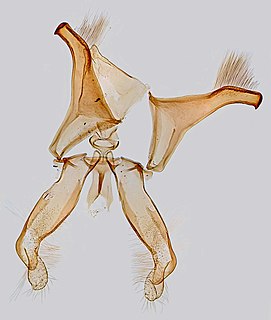
The Pterophoridae or plume moths are a family of Lepidoptera with unusually modified wings. Though they belong to the Apoditrysia like the larger moths and the butterflies, unlike these they are tiny and were formerly included among the assemblage called "microlepidoptera".

Hellinsia tephradactyla is a moth of the family Pterophoridae found in most of Europe. It was first described by the German taxonomist Jacob Hübner in 1813.

Hellinsia is a genus of moths in the family Pterophoridae.
Platyptilia isodactylus is a moth of the family Pterophoridae found in China, Europe and was introduced to Australia for biological control. It was first described by the German entomologists, Philipp Christoph Zeller in 1852.

Hellinsia lienigianus is a moth of the family Pterophoridae which inhabits coastal areas, dry pastures and waste ground and is found in Africa, Asia, Australia and Europe. Also known as the mugwort plume it was first described by Philipp Christoph Zeller in 1852.

Platyptilia farfarellus is a moth of the family Pterophoridae. The species was described by Philipp Christoph Zeller in 1867. It is found from central and southern Europe to Asia Minor, Micronesia and Japan. It is also known from Africa, where it has been recorded from Equatorial Guinea, Kenya, Madagascar, Mauritius, Nigeria, South Africa, São Tomé & Principe, Tanzania, Uganda, the Seychelles and Malawi.
Agdistis tamaricis is a moth of the family Pterophoridae found in Africa, Asia and Europe. It was first described by the German entomologist, Philipp Christoph Zeller in 1847.

Oxyptilus pilosellae is a moth of the family Pterophoridae first described by Philipp Christoph Zeller in 1841. It is found in most of Europe, east to Russia and Asia Minor. It was released as a biological control agent for Hieracium in New Zealand in 1998.

Crombrugghia distans, also known as the Breckland plume is a moth of the family Pterophoridae found in Africa, Asia and Europe. It was first described by Philipp Christoph Zeller in 1847.

Crombrugghia laetus, also known as the scarce light plume is a moth of the family Pterophoridae, found in southern Europe, North Africa, the Canary Islands, Asia Minor and Iraq. It was first described by Philipp Christoph Zeller in 1847.

Platyptilia calodactyla is a moth of the family Pterophoridae found in Asia and Europe. It was first described by the Austrian entomologists, Michael Denis & Ignaz Schiffermüller in 1775.

Merrifieldia baliodactylus, also known as the dingy white plume, is a moth of the family Pterophoridae found in most of Europe. It was first described by the German entomologist, Philipp Christoph Zeller in 1841.
Hellinsia chrysocomae, also known as the scarce goldenrod plume moth, is a moth of the family Pterophoridae, found in Great Britain, France, Germany, Switzerland and southern Russia.

Hellinsia carphodactyla is a moth of the family Pterophoridae, first described by Jacob Hübner in 1813. It is known from most of Europe, Asia Minor and North Africa.

Coleophora conspicuella is a moth of the family Coleophoridae found in Asia and Europe. It was first described by Philipp Christoph Zeller in 1849.

Hellinsia paleaceus is a moth of the family Pterophoridae described by Philipp Christoph Zeller in 1873. It is found in North America, including Florida, Mississippi Maryland, Montana, Texas, California, Nebraska, New Mexico and south-eastern Canada. It has also been recorded from Puerto Rico.














